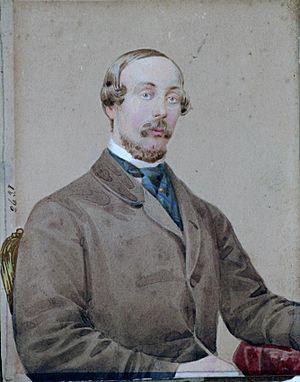John Birmingham (astronomer) facts for kids
Quick facts for kids
John Birmingham
|
|
|---|---|
 |
|
| Born | 1816 Millbrook Estate near Milltown, County Galway, Ireland
|
| Died | 7 September 1884 (aged 67–68) Millbrook Estate
|
John Birmingham (1816–1884) was an Irish scientist who loved studying the stars. He was an astronomer, a geologist (someone who studies rocks), and even a poet! He traveled a lot in Europe and learned many languages. In 1866, he found a special type of star called a nova named T Coronae Borealis. He also wrote about planets, meteor showers, and sunspots.
Contents
Early Life and Discoveries
John Birmingham was born to Edward Birmingham and Elly Bell in 1816. He grew up on the Millbrook Estate near Milltown, County Galway, Ireland. He went to school at St Jarlath's College in Tuam.
Between 1844 and 1854, John traveled around Europe for many years. He might have studied in Berlin during this time. When he came back home in 1854, he started writing articles for newspapers and magazines. These articles were about science and other interesting topics. He first became known for his writings about rocks in western Ireland.
In 1865, John inherited part of the Millbrook estate. He settled at Millbrook House with his aunts and an uncle. People knew him as a kind landlord and also as a smart scholar.
Building an Observatory
From 1858, John started writing notes about astronomy for local newspapers. At Millbrook, he built his first observatory. It was a large wooden house with a roof that could slide open! This allowed him to look at the night sky.
On May 12, 1866, he made an exciting discovery. He found a variable star called T Coronae Borealis in the constellation Corona Borealis. A variable star is one that changes its brightness over time. Because of this success, he bought a powerful new telescope. It cost £120, which was a lot of money back then! The telescope had a special lens made by Thomas Grubb of Dublin.
The Birmingham Lunar Crater
In 1866, John Birmingham wrote an essay about something strange on the Moon. He wrote about a crater that seemed to disappear. In its place, a huge bright cloud appeared!
The Irish Times newspaper reviewed his essay. They said it showed how much he had learned. They also praised his charming writing style. In 1883, the Royal Irish Academy gave John Birmingham a gold medal. This was to honor his important contributions to their scientific papers.
About the Crater
Today, there is a crater on the Moon named after John Birmingham. It is located near the northern edge of the Moon. From Earth, we see it at a low angle.
The original crater is mostly gone. All that is left is an uneven ring of low ridges. Inside this ring, the surface was covered by lava long ago. The inner floor has many tiny smaller craters. The surface is also rough in an unusual way. Because of the low angle of sunlight, you can see fine details of this rocky area. The Birmingham crater is just north of the Mare Frigoris and east of another walled-plain called W. Bond.
Studying Red Stars
John Birmingham used his 4.5-inch (110 mm) Cooke telescope to study red stars. He updated and added to a list of red stars made by Hans Schjellerup. His new list included 658 of these objects.
He presented this important work to the Royal Irish Academy in 1876. For this, he received the Cunningham Medal. In 1881, he found a very deep red star in the Cygnus constellation. This star is now named after him!
John also published articles on other topics. These included meteor showers, the transit of Venus (when Venus passes in front of the Sun), and sunspots. He often wrote letters to other leading astronomers of his time.
Later Life
John Birmingham was an only child. He never married. He passed away at the Millbrook Estate on September 7, 1884. After his death, his house fell into ruin. John Birmingham was a very religious Catholic.
Today, the only thing left of his belongings is his telescope. You can see it on display at the Milltown community museum. During his life, John was well-known and respected by many. Other famous astronomers, like Robert Stawell Ball, even mentioned Birmingham's observatory in their books. John also had many contacts at the Dunsink Observatory.

